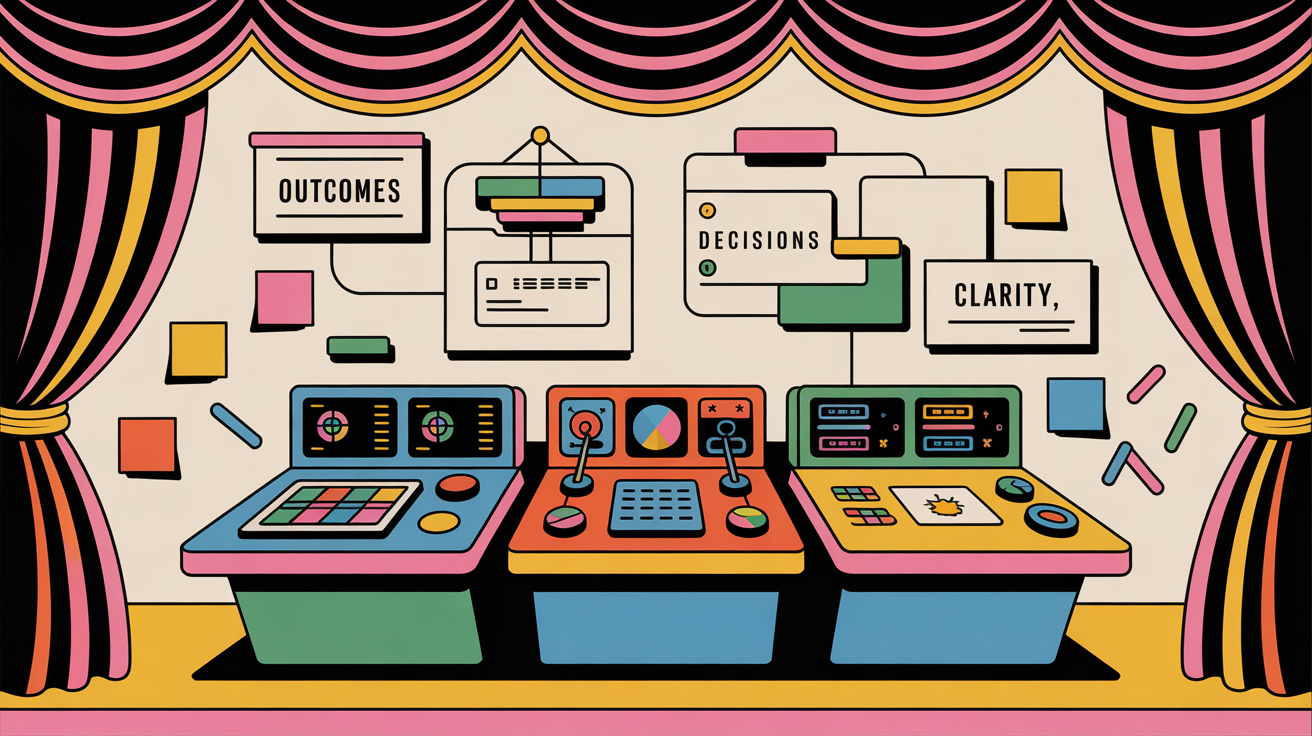When the room disappeared, so did the people who built their identity around being in it. For years, design leadership was a choreography of presence: the right energy at the whiteboard, the right facilitation to make people feel heard, the right meeting to suggest progress was happening. There was always a room—alive with sticky notes and soft power—and many leaders learned to play it like an instrument.
Then the office doors closed. The room became a grid of faces, then just initials, then recordings nobody watched. Engagement slipped to the kind of numbers you only see in downturns. Designers—talented, motivated, capable—began to feel strangely disconnected in spite of an abundance of tools. Innovation, once a verb, calcified into theater: ceremonies that looked like momentum but rarely produced outcomes. Whiteboarding survived as a ritual, but its purpose thinned. You could feel the gap widen between the talk and the shipping.
The first instinct for many leaders was to rebuild the stage online. More meetings, tighter agendas, cameras on. If we could recreate the ritual, perhaps we could recreate the results. But the more the calendar filled, the more the work receded. People stopped showing up mentally long before they stopped showing up physically. Presence—always a shaky proxy for leadership—finally revealed itself as the hollow metric it was.
The leaders who thrived took a different path. They didn’t try to port the office to Zoom; they redesigned leadership for a world where time and attention are the scarcest resources. They traded performance for purpose. The job stopped being “curator of meetings” and became “architect of remote systems.” In their hands, the work moved from conversation to clarity.
The shift is subtle, but once you see it, you can’t unsee it. Instead of corralling people into brainstorms, they framed problems so crisply that good ideas had a place to land. Instead of status meetings, they wrote narratives—short, sharp updates that captured what changed, what was learned, and what was next. Decisions stopped living in someone’s head or in a fleeting call; they lived in artifacts: memos, logs, design drafts that evolved with the work. Sync time became sacred and short, reserved for the hard choices where nuance and pressure matter. Everything else flowed through well-designed documents and asynchronous critiques that respected deep work.
These leaders built leverage instead of dependency. They codified what “good” looks like, not as commandments but as guardrails: how we frame a problem, how we evaluate a design, how we decide when to stop. They gave their teams tools to make decisions without them—heuristics, templates, scorecards—so that leadership scaled beyond their calendars. They learned to coach with comments more powerful than a dozen calls. Their teams grew quieter in meetings and louder in artifacts. Momentum became visible in changelogs and commits rather than calendar invites.
Culture didn’t vanish; it changed shape. It migrated into intentional rituals that didn’t depend on co-location: a weekly product narrative that everyone could read in ten minutes; critiques where work was shared a day in advance, so live time was about decisions, not discovery; shout‑outs that captured real collaboration, not performative praise; onboarding that didn’t rely on osmosis but on a “this is how we work” manual, generous with examples. Time zones stopped being a tax and became a flow: work moved while you slept, with decisions waiting in the morning, neatly logged and easy to trace.
Outcomes—finally—reclaimed center stage. Not hours in meetings. Not how many workshops, how many comments, how many boards. The questions changed: Did this design shrink time‑to‑value? Did activation improve? Did this flow retire a real risk? Leaders began to love kill decisions almost as much as launches, because a validated “no” freed up more future than an unexamined “yes.”
The organization reshaped itself around this reality. Small squads with clear missions and metrics, researchers embedded where learning happens, staff designers operating as multipliers across teams—elevating principles, patterns, and bets that matter. Leadership cadence simplified: a monthly strategy pulse, a biweekly portfolio view, a brief weekly review of risks. Everything else lived in writing.
And the old habits? They died hard. The all‑hands brainstorm with no pre‑work. The camera‑on mandates masquerading as culture. The instinct to measure motion instead of movement. But once teams experienced the calm confidence of clarity—fewer meetings, faster cycles, deeper work—the theater felt impossible to return to. The room, it turned out, wasn’t where the leadership lived. It was where the leadership hid.
Here’s the hard truth: a lot of design leadership was expensive theater. Remote work didn’t kill it; it made it visible. The leaders winning now treat leadership itself like a product. They design it. They measure it. They iterate. They remove friction where the work happens and apply pressure where the decisions are made. They optimize not for facetime, but for decision speed and customer impact.
If you’re feeling the drag of the old model, start small. Take one recurring meeting and turn it into an artifact with a clear owner and a deadline. Write it down. Share it early. Ask for the decision you need, not the time you want. Then watch what happens to your cycle time, to your team’s energy, to your own calendar. That’s the quiet revolution: less performance, more purpose. Less presence, more impact. Fewer meetings. More making.
And if you’re still nostalgic for the room, remember: the best rooms were never about the walls. They were about the work.


Leave a Reply